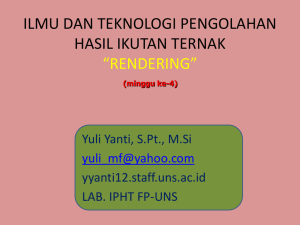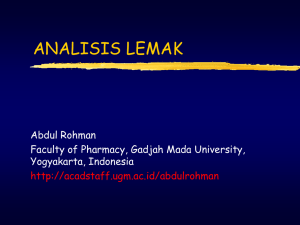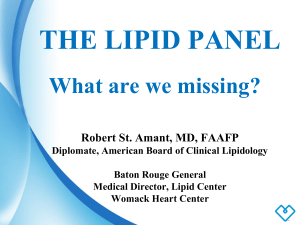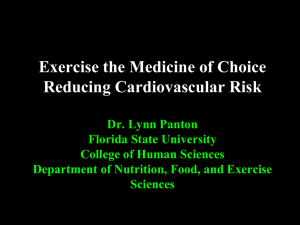LEMAK : Struktur, Fungsi dan Metabolisme
advertisement
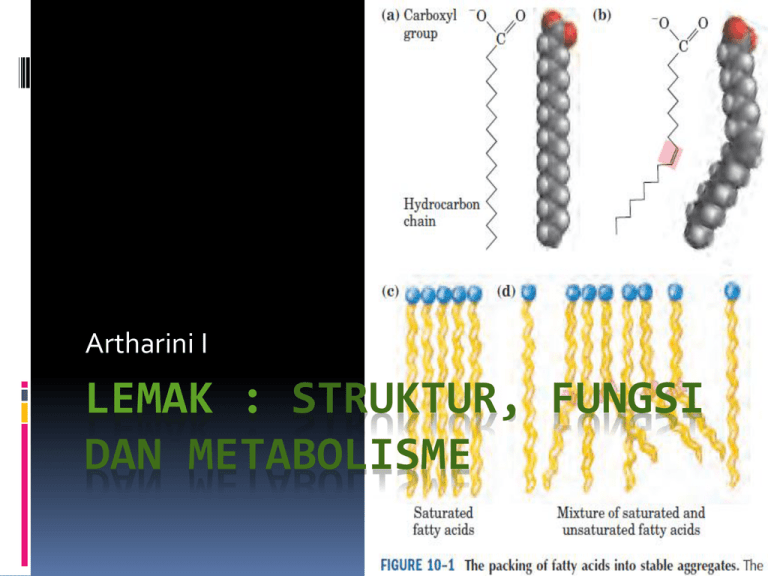
Artharini I LEMAK : STRUKTUR, FUNGSI DAN METABOLISME LEMAK ??? kolesterol Obesitas Hipertensi diabetes Jantung Health issues Excessive dietary fat intake is associated with obesity, diabetes, cancer, hypertension and atherosclerosis. Not more than 35% of energy intake should come from fat. Saturated fat should not make up more than 15% of the total fat intake. Omega-3 fatty acids (20 carbons) from fish may protect against atherosclerosis. American Heart association recommends 2-3 fish meals per weak. Fish oil supplements should be avoided because they may be contain concentrated toxins accumulated by the fish. DEFINISI LEMAK Senyawa yang larut dalam pelarut lemak, seperti kloroform, benzena, hexan, aseton dan eter. Ester asam lemak dan gliserol (trigliserida) Bentuk padat : lemak cair : minyak Kenapa energinya lebih tinggi? Kandungan C, H dan O C H O Lemak 77 12 11 Pati 44 6 50 Komponen struktural membran sel Sebagai sumber energi, umumnya dalam bentuk trigliserida Pelarut vitamin yg larut pada lemak Sebagai prekursor biosintetik ( hormon steroid dari kolesterol) Untuk memproteksi (contoh melapisi ginjal) Untuk insulasi panas FUNGSI: SIFAT UMUM LEMAK Relatif tidak larut dalam air Larut dalam pelarut non polar (eter, kloroform) Merupakan konstituen makanan yg penting ( energinya lebih tinggi, adanya vitamin larut dlm lemak, asam lemak essensial) Disimpan di jaringan adiposa insulator panas Kombinasi lipid dengan protein alat pengangkut lipid dlm darah KLASIFIKASI LEMAK (Harper) LIPID SEDERHANA Ester asam lemak dengan berbagai alkohol - Lemak (fat) : ester as. Lemak dengan gliserol; minyak (oil) lemak dlm kondisi cair - wax (malam) : ester asam lemak dg alkohol monohidrat berberat molekul tinggi 2. LIPID KOMPLEKS Ester asam lemak yg mgd gugus2 selain alkohol dan asam lemak - Fosofolipid - Glikolipid - lipid kompleks lain (sulfolipid, aminolipid) 3. PREKURSOR DAN LIPID TURUNAN -asam lemak, gliserol, steroid, alkohol lain, aldehid lemak,badan keton, hidrokarbon, vitamin larut lemak dan hormon. 1. Classification Bloor’s Classification A. Simple lipid - ester of fatty acids with various alcohols 1. Natural fats and oils (triglycerides) 2. Waxes (a) True waxes: cetyl alcohol esters of fatty acids (b) Cholesterol esters CH3 CH3 E E CH3 E E OH (c) Vitamin A esters CH3 CH3 (d) Vitamin D esters B. Compound lipid - esters of fatty acids with alcohol plus other groups 1. Phospholipids and spingomyelin: contains phosphoric acid and often a nitrogenous base 2. Spingolipids (also include glycolipids and cerebrosides): contains aminoalcohol spingosine, carbohydrate, N-base; glycolipids contains no phosphate 3. Sulfolipids : contains sulfate group 4. Lipoproteins : lipids attached to plasma/other proteins 5. Lipopolysaccharides: lipids attached to polysaccharides Classification cont. C. Derived lipids – hydrolytic products of A & B with lipid characters 1. Saturated & unsaturated fatty acids 2. Monoglycerides and diglycerides 3. Alcohols (b-carotenoid ring, e.g., vitamin A, carotenoids) certain D. Miscellaneous lipids 1. Aliphatic hydrocarbons: found in liver fat and certain hydrocarbon found in beeswax and plant waxes 2. Carotenoids 3. Squalene : found in shark and mammalian liver and in human sebam; an important intermediate in biosynthesis of cholesterol 4. Vitamin E and K CH2OH CHOH CH2OH Gliserol HOOC-R + HOOC-R --- HOOC-R asam lemak CH2-OOC-R CH-OOC-R + 3H2O CH2-OOC-R lemak air Fats and oils: Vegetable oils are triglycerides that are liquid at room temp due to their higher unsaturated or shorter-chain fatty acids Triglycerides are most abundant natural lipids Natural fats have D-configuration Usually R1 and R3 are saturated and R2 is unsaturated Natural fats are mixture of two or more simple triglycerides “ A fatty acid may be defined as an acid that occurs in a natural triglyceride and is a mono carboxylic acid ranging in chain length From four carbon to 24 carbon atoms and including , with exceptions, only the even-numbered members of the series ” SIFAT Ditentukan o/ susunan as.lemaknya: Jenuh/saturated (CnH2nO2) 2. Tidak jenuh/unsaturated (CnH2n-xO2) Punya 2 atau lebih molekul H yg hilang Esensial bagi tubuh 1. Most Common Fatty Acids in Di- and Triglycerides Fatty acid Carbon:Double bonds Double bonds Myristic 14:0 Palmitic 16:0 Palmitoleic 16:1 Stearic 18:0 Oleic 18:1 Cis-9 Linoleic 18:2 Cis-9,12 Linolenic 18:3 Cis-9,12,15 Arachidonic 20:4 Cis-5,8,11,14 Eicosapentaenoic 20:5 Cis-5,8,11,14,17 Docosahexaenoic 22:6 Cis-4,7,10,13,16,19 CH3(CH2)nCOOH Cis-9 Sumber : Lehninger, Sumber : Lehninger, Fatty Acid Isomers Forages Fat content is low: 1 to 4% of dry matter High proportion of linolenic acid (18:3) Diglycerides in fats of leaves Grains Fat content variable: 4 to 20% of dry matter High proportion of linoleic acid (18:2) Triglycerides in oils of seeds Sumber : Lehninger, REAKSI KIMIA & SIFAT KHAS LEMAK 1. A. B. HIDROLISIS ENZIMATIK trjd dlm pencernaan DG ALKALI (PENYABUNAN) Lipida+alkali gliserol grm alkali as.lemak REAKSI KIMIA & SIFAT KHAS LEMAK 2. ANALISIS a. Bil.Penyabunan adalah jml mg KOH u/menyabunkan 1 gr lemak b. Bil.As adalah jml mg KOH u/menetralkan as.lemak bebas dr 1 gr lemak c. Bil.Polenske adalah jml mg KOH u/menetralkan as.lemak yg tdk larut (yg bukan atsiri dlm destilasi uap) dr 5 gr lemak REAKSI KIMIA & SIFAT KHAS LEMAK d. Bil.Iodium (ukuran derajat ketidakjenuhan) - jml gr iodium yg diserap o/ 100 gr lemak (tiap ik.ganda dlm lemak dpt mengambil 2 atom iodium) e. Uji ketengikan (ukuran derajat ketengikan) - Bil Peroksida (dg KI) - Uji As.Tiobarbiturat - Uji Oven Schaal KETENGIKAN 1. 2. HIDROLITIK a. Adanya lipase bs menyebabkan reaksi ini, terbentuk as.lemak+gliserol b. nilai gizi tdk terpengaruh OKSIDATIF a. Trjd krn adanya oksigen b. menurunkan nilai energi dr lemak METABOLISME LEMAK Istilah2 terkait dengan Metab. Lemak Lipogenesis Beta Oksidasi Lipid Metabolism MEMBRAN LIPIDS Glycerophospholipid Galactolipid Sulfolipid Sphingolipid sterol Glycerophospholipids Glycerophospholipids (phosphoglycerides), are common constituents of cellular membranes. They have a glycerol backbone. Hydroxyls at C1 & C2 are esterified to fatty acids. An ester forms when a hydroxyl reacts with a carboxylic acid, with loss of H2O. C H 2O H H C OH C H 2O H g lycero l F orm ation of an ester: O R 'O H + H O -C -R " O R '-O -C -R '' + H 2 O Phospholipids • Phospholipids consist of a 3-carbon glycerol linked to a negatively charged phosphate group, and two fatty acids. • Phospholipids are a major component of cell membranes due to their amphipathic nature. • Amphipathic molecules have a nonpolar region (hydrophobic) and a polar region (hydrophilic). 41 Sphingolipids are derivatives of the lipid sphingosine, which has a long hydrocarbon tail, and a polar domain that includes an amino group. OH H 2C OH H C H 3 N+ CH CH HC O O P O ( CH 2 ) 12 sphingosine O H 2C OH H C H 3N + CH CH HC (C H 2 ) 1 2 sphingosine -1 -P CH3 CH 3 Sphingosine may be reversibly phosphorylated to produce the signal molecule sphingosine-1-phosphate. Other derivatives of sphingosine are commonly found as constituents of biological membranes. CH 3 H 3C Sphingomyelin has a phosphocholine or phosphethanolamine head group. Sphingomyelins are common constituent of plasma membranes N + O H2 C H2 C O CH 3 P O O phosphocholine H 2C sphingosine O fatty acid Sphingomyelin OH H C CH NH CH C R HC ( CH 2 ) 12 CH 3 Sphingomyelin, with a phosphocholine head group, is similar in size and shape to the glycerophospholipid phosphatidyl choline. b-oxidation yields large amounts of ATP The energy conversion process of fatty acid --> ATP involves oxidation of fatty acids by sequential degradation of C2 units leading to the generation FADH2, NADH, and acetyl CoA. Palmitate (C16) The subsequent oxidation of these reaction products by the citrate cycle and oxidative phosphorylation generates lots of ATP. 106 ATP - WOW! b-oxidation reactions OXIDATION The b-oxidation pathway occurs at the b carbon of the fatty acid, thereby releasing the C-1 carboxyl carbon and carbon as the acetate component of acetyl CoA. HYDRATION OXIDATION THIOLYSIS b-oxidation reactions for palmitate (C16) Palmitoyl-CoA + 7 CoA + 7 FAD + 7 NAD+ + 7 H2O --> 8 acetyl CoA + 7 FADH2 + 7 NADH + 7 H+ ATP currency exchange ratios 31 NADH (31 x ~2.5 ATP) = ~77.5 ATP 15 FADH2 (15 x ~1.5 ATP) = ~22.5 ATP For a grand total = 100 ATP After subtracting the 2 ATP required for fatty acyl CoA activation (AMP --> PPi) And adding the 8 ATP obtained from eight turns of the citrate cycle; The total payout for the complete oxidation of palmitate is 106 ATP b-oxidation is a chemical source of water for desert animals Besides the payout of ATP that comes from fatty acid oxidation, another benefit is the generation of H2O that occurs when O2 is reduced by the final reaction in the electron transport system, as well as, the formation of H2O in oxidative phosphorylation. 2 NADH + 2 H+ + O2 --> 2 H2O 2 FADH2 + O2 --> 2 H2O ADP + PO42- --> ATP + H2O Ketogenesis When fatty acid oxidation produces more acetyl-CoA than can be combined with OAA to form citrate, then the "extra" acetyl-CoA is converted to acetoacetyl-CoA and ketone bodies, including acetone. Ketogenesis (synthesis of ketone bodies) takes place primarily in the liver. Ketogenesis Acetyl-CoA derived from fatty acid oxidation enters the Citrate Cycle only if carbohydrate metabolism is properly balanced. When fatty acid oxidation produces more acetyl-CoA than can be combined with OAA to form citrate, then the "extra" acetyl-CoA is converted to acetoacetyl-CoA and ketone bodies, including acetone. Ketogenesis (synthesis of ketone bodies) takes place primarily in the liver. Ketones are an energy source for tissues How many total ATP from 2 acetyl-CoA? 6 NADH 2 FADH2 2 GTP 15 ATP 3 ATP 2 ATP 20 ATP Ok, now what happens to these two acetyl-CoA? Ketogenesis occurs when glycogen stores are depleted such as during fasting and in undiagnosed diabetics Diabetics can have high levels of acetone in their blood which can be detected on their breath as a fruity odor. Acetone is a spontaneous breakdown product of acetoacetate (decarboxylation), or it is formed by enzymatic cleavage of acetoacetate by the enzyme acetoacetate decarboxylase. Lipoprotein and lipid transport • Since cholesterol is hydrophobic (water fearing) and blood is hydrophilic (water loving), the two do not mix. • Cholesterol is carried through the bloodstream in protein packages called lipoproteins, made up of lipid on the inside and protein on the outside. • Two kinds of lipoproteins carry cholesterol throughout your body. - High density lipoproteins (HDL) - Low density lipoproteins (LDL) 58 LDL and HDL continued…. • LDL cholesterol is sometimes called bad cholesterol. – High LDL cholesterol leads to a buildup of cholesterol in arteries. The higher the LDL level in your blood, the greater chance you have of getting heart disease. • HDL cholesterol is sometimes called good cholesterol. – HDL carries cholesterol from other parts of your body back to your liver. The liver removes the cholesterol from your body. The higher your HDL cholesterol level, the lower your chance of getting heart disease. 59 Hyperlipidemia can lead to disease • When there is too much cholesterol /LDL in your body (because of diet and the rate at which the cholesterol is processed) it is deposited in arteries, including those of the heart, which can lead to narrowing of the arteries and heart disease. • Studies of people with heart disease have shown that lowering cholesterol/LDL reduces the risk for dying from heart disease, having a heart attack, or needing heart bypass surgery or angioplasty. 60 Lipoprotein Profile • Cholesterol levels are measured in milligrams (mg) of cholesterol per deciliter (dL) of blood. • Desirable or optimal levels for adults with or without existing heart disease are: – Total cholesterol: Less than 200 mg/dL. – Low Density Lipoprotein (LDL) cholesterol: Less than 100 mg/dL. – High Density Lipoprotein (HDL): 40 mg/dL or higher. – Triglycerides: Less than 150 mg/dL. • The National Cholesterol Education Program recommends that healthy adults over 20 years of age have their cholesterol levels checked once every 5 years. 61
